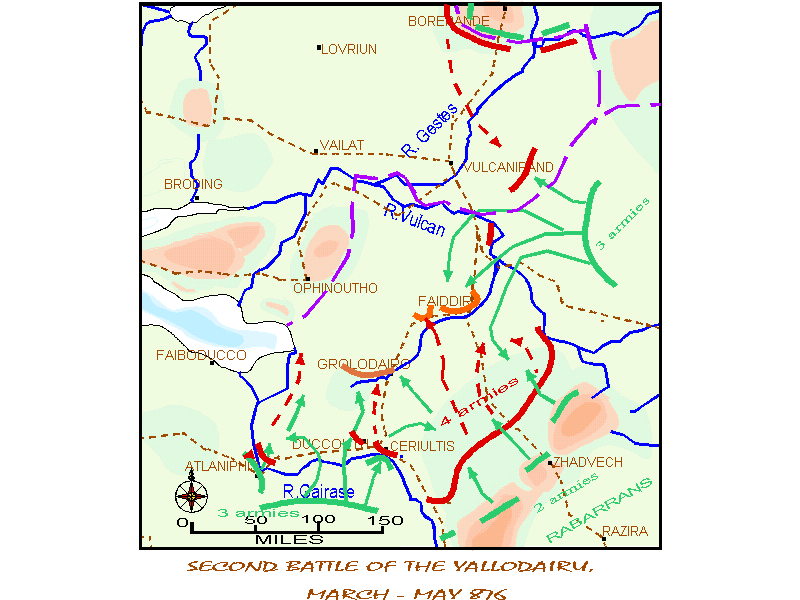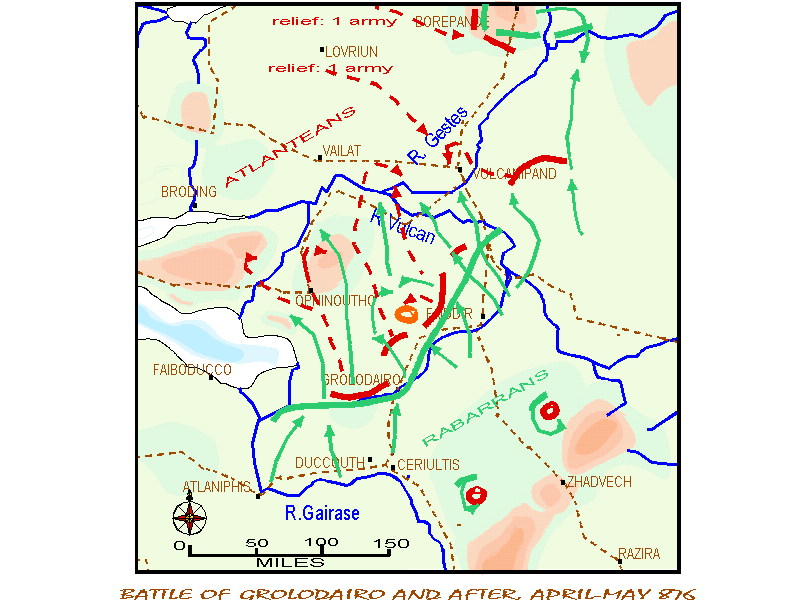|
Home Page
Discovery of Atlantis
First Empire-(1) to 261
Second Empire- (1) 361 - 409 |
|
The Atlantean armies sped south-eastwards towards the Raziris mountains, and by the beginning of November they had halted in the higher ground north-west of these mountains, on a front stretching for a hundred miles between the rivers Gairase and Vulcan. They had largely ignored their flanks hitherto, but in fact there were a number of Rabarran forces west of the Gairase, which could become threatening. As a result, at this point, the Atlanteans decided they needed to seize bridgeheads over the river Gairase, to protect their flank here, and as a preparation to crossing that river and invading Manralia. Moreover, there were dangerous events taking place around the Helvengio. Following the Atlantean invasion across the Gestes, the Rabarrans began their planned strategy, under the leadership of the commander for this front, Iferire Alauqo. They attacked the Atlantean bridgehead near Miolrel, and wiped it out within three weeks. Then, at the end of September, their western navy slipped back into the Helvengio. It combined with the fleets already there, made for the Atlanteans off Helvremon, and defeated them. They then proceeded to blockade Giezuat in October, and again defeated an attempt at relief by the Atlanteans from Helvris. There then followed an amphibious invasion of the island by the Rabarrans, which was entirely successful by December. A second sortie by the Atlantean fleet after this was more successful, but was too late to save the island of Helvremon. These events confirmed the Atlanteans in their plans for the new year, namely to move west and occupy the south shore of the Helvengio, thereby cutting off the invaders of the Helvremon. However, there was no intention of starting this until at least April, and in the meantime, some two armies were directed to seize the towns of Atlaniphis and Ceriultis on the Gairase. Both of these were easily defended by the Rabarrans, who already had 200000 men in Manralia: these were now increased to 300000. Fighting raged in terrible winter conditions for two months, but the Atlanteans made very little progress. Meanwhile, they kept most of their forces – up to four armies - facing the Raziris Mountains. To the north of the Vulcan, they had just one army, set way back to the west. The Rabarrans now decided to seize the chance offered by the risky disposition of the Atlantean armies, and attack them on both flanks, across the Gairase at between Atlaniphis and Ceriultis, and across the Vulcan, on either side of the Yallodairu. To this end, they secretly and successfully amass armies of 300000 men in both these positions, leaving just 200000 to man the Raziris Mountains. THE RABARRAN COUNTER-ATTACK ROUND THE FLANKS OF THE ATLANTEANS: THE
SECOND BATTLE OF THE YALLODAIRU,
The Rabarrans now shifted their centre, and leaving three armies in the west, they pushed two against the enemy hanging back some way to the north of Grolodairo. To the east of these, their remaining forces also turned west behind the Atlantean force near Grolodairo, while the rest moved straight towards Vulcanipand, the main line of supply and crossing-point for the whole Atlantean Army in this area. The latter move, as well as the central punch near Grolodairo brought the Rabarrans a second victory in the Battle of Grolodairo. The Atlanteans west of Grolodairo retreated again to the Avlotans hills near Iutieh. In the north-east, the small Atlantean force north of the Vulcan, attacked in front, and threatened in its rear as the Rabarrans moved on Vulcanipand, was just able to retire across the Gairase and into the fortress in time. By May, the Atlanteans on the avlotans and about Ophinoutho were forced yet again to retreat across the Gayvot to the kavotans mountains. Elsewhere the rest of the Atlanteans who had escaped the debacle had collected behind the Gestes, with Vulcanipand as their centre. To the north, Rabarran troops from the Vulcan had moved north and joined hands with the Borepande garrison. Part of the Atlantean force which had been blockading this from the west had had to move south to help with the defence of the Gestes, but two new armies of reinforcements were rushed to the front during May. To read the next part of this history, click on (3) 876 - 877 |

